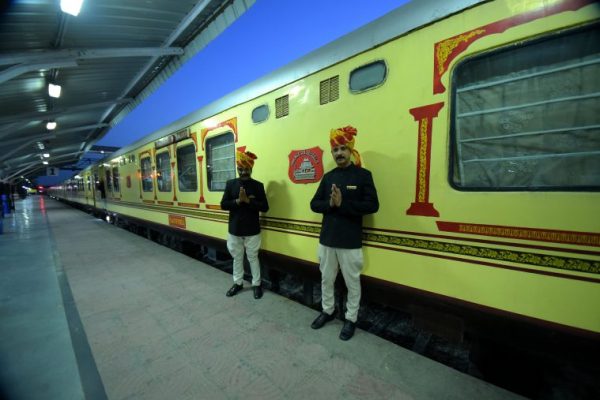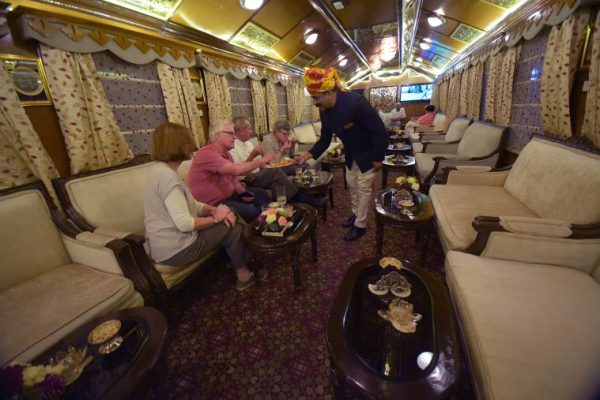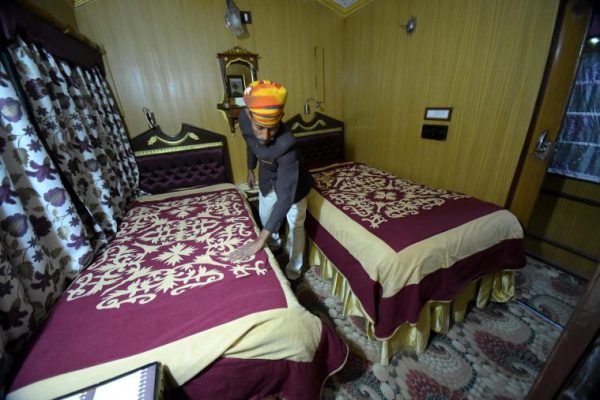The Royal Challenge
Palace on Wheels, the mother of luxury rail travel in India, is facing a crisis as the number of tourists hopping aboard the train is dwindling.
 Palace on Weels in Jaipur on Friday (Express photo by Rohit Jain Paras)
Palace on Weels in Jaipur on Friday (Express photo by Rohit Jain Paras)
I have never had a dull tour.” Barring the four months in 1994 when he was sent to hone his skills in London, for the last 34 years, head chef Subesh Singh has been cooking for guests aboard the Palace on Wheels, treating them to Indian delicacies such as murg shorba or mutton rogan josh and paneer nazakat.
“Staying together for a week naturally leads to bonding between the staff and guests, and everyone is full of stories and anecdotes. Some have had complaints, though,” he says. His is a mobile kitchen, and Singh works with a fixed meals menu (with an emphasis on Indian cuisine, followed by Chinese and continental) between 5 am and 11 pm. He purchases groceries thrice during the week-long tour, which always begins on a Wednesday from New Delhi. The Palace on Wheels (PoW) travels to Jaipur, Sawai Madhopur, Chittorgarh, Udaipur, Jaisalmer, Jodhpur, Bharatpur, Agra and back to Delhi. The train stops at each of these places, and the tourists are escorted to the local sights such as the Chittorgarh fort, Ranthambore National Park, the lakes of Udaipur and the Taj Mahal.
But last month, on March 30, there was an “unusual” development. For the first time since 1982, there were no bookings; and though the tour got back on track a week later with 45 tourists, the first-ever cancellation was a bitter pill to swallow.
It was hardly surprising, though. Luxury rail travel has been under the weather for a while now. For PoW, the number of passengers has dwindled from 2,883 (or 79 per cent occupancy) in 2011-12, to 1,739 in 2015-16. Each season lasts from September to April.
 Tourists inside the Palace on Weels bar in Jaipur on Friday (Express photo by Rohit Jain Paras)
Tourists inside the Palace on Weels bar in Jaipur on Friday (Express photo by Rohit Jain Paras)
According to a 2004 study by Mustafa Malik of Aligarh Muslim University, titled “Role of Indian Railways in the promotion of tourism: A case study of Palace on Wheels”, it was a BBC series, Great Rail Journeys of the World (1980), that led to the inception of the PoW. Soon, the rail authorities began to plan a project to “attract foreign tourists, particularly those from the UK”, where the series, and especially the feature on India, had generated much interest.
In March 1981, the Ministry of Commerce put forward a draft of the proposal for a pilot project at the Indo-British Economic Cooperation (IBEC) talks. Soon, the Board of Trade of the UK government extended their cooperation as well. “The proposal defined the project as a hotel on wheels that is mobile at night and stationary during the day at a particular destination, so that the tourists can move around,” says Pradeep Bohra, 59, PoW’s general manager, who was a young joint assistant manager at the Rajasthan Tourism Development Corporation (RTDC) in the 1980s. RTDC runs PoW with the Indian Railways on a 44:56 profit sharing basis.
In 1982, PoW was launched by restoring old saloons dating to the early 20th century that belonged to erstwhile maharajas of the princely states of Rajputana (Rajasthan) and Gujarat, the Nizam of Hyderabad and the former viceroys of British India. “The saloons of the original PoW included a coach built in 1907 for the Maharaja of Bhavanagar, which had an ornamented ceiling and teak-body panels. Another saloon, built for the Maharaja of Jaipur in 1936, had verandas covered with flower motifs on both sides and the exterior was painted in white with purple and brown lines at the windowsills. The Viceroy’s Carriage, a popular saloon, was manufactured in 1913 and used by the Maharajas of Rajputana,” writes Malik.
 Palace on Weels in Jaipur on Friday (Express photo by Rohit Jain Paras)
Palace on Weels in Jaipur on Friday (Express photo by Rohit Jain Paras)
An undated boat-shaped carriage with woodwork inside, made for the Maharana of Udaipur (Mewar), was converted into a restaurant annexe. “The furniture provided in it could be folded to convert this car into a discotheque, and was equipped with disco lighting and music arrangements,” says Malik. The oldest saloon belonged to the Maharaja of Bikaner and dated back to 1898.
However, within a decade, the coaches developed technical problems, and were replaced by a new, fully air-conditioned train in 1991. Soon after, the Indian Railways implemented the uni-gauge project, and a third version of PoW was brought on broad gauge tracks in 1995, which continues till today.
The current PoW has 22 coaches, out of which 14 are passenger saloons, named after princely states of Rajasthan — Jaipur, Kota, Bharatpur, Bikaner, and others. Each is equipped with four cabins and an en suite bathroom. There are two restaurant-cum-kitchen cars, a bar, a spa, and two coaches each for the staff and the engineers who drive the train.
Like most foreigners who board the PoW, Nigel Bacon, a retired general practitioner, has a link with India. “In 1959, when my father was posted at the Australian High Commission in Delhi, I would come to India during my vacations,” he says. Nearly 57 years later, the Australian has returned and found comfort in the PoW. He’s here with his wife Judith and their friends, Ron and Lynn, all in their 50s and 60s. “We are happy to let go of ‘responsibility’ while we’re on the train,” says Bacon. For approximately 400 USD per person, per day on the PoW, all they have to do is put their feet up.
Back at the RTDC office in Jaipur, an officer says that the selling point of the PoW lies in the hospitality of the staff, and that it comes closest to recreating the “ghulam” setting of the Raj, within reasonable limits, of course, as another officer shushes him up. “Since India was once a British colony, the PoW has traditionally attracted the maximum number of tourists from the UK. The British brought the railways to India, and their forefathers have been here, so they come back to experience what it would have been like then,” said Bohra. “The British tourists are followed by those from the USA and Australia, some NRIs, and the rest from other countries,” he says.
The PoW has a staff of 62-42 from RTDC and 20 from Indian Railways. RTDC staff includes three in management, 14 each of house assistants/saloon captains and room attendants, five chefs, three kitchen helpers, a store keeper and two barmen. Indian Railways’ staff includes eight security personnel as well as the train superintendent, maintenance crew, driving crew and wireless operators. “House assistants are fluent in English, they can prepare and serve breakfast, while room attendants are tasked with maintaining cleanliness. The tourists are very particular about who is cleaning the toilets and who is preparing their meals,” says Bohra.
Pradeep Singh, 47, who is the Jodhpur Saloon captain, reaffirms that “tourists primarily come abroad to experience the days of the Raj and to see what it is to live like kings and queens.” Prabhu Singh, 58, a salon attendant, says that the key is “to be at your polite best at all times.”
After a long day, before PoW begins to journey through the night and gently lull its passengers to sleep, barman Sanjay Mathur is ready to soothe their bones with a variety of top scotch, wine and cocktails. As for the PoW, at 48 per cent occupancy this season, it may be down but it’s not out. About 420 bookings have already been made for the next season.



- 01
- 02
- 03
- 04
- 05
























